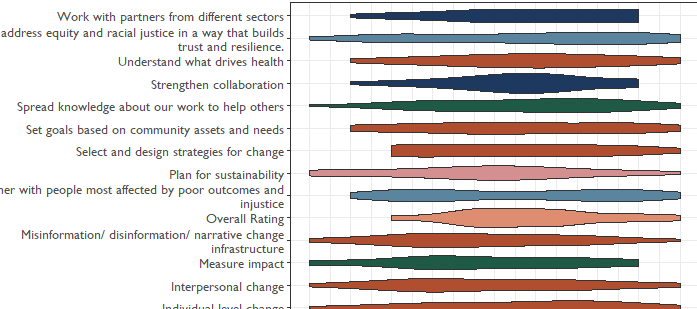Community capacity building is hard. That is no secret. Oftentimes, community teams have a challenge just identifying both the strengths and their areas for growth. This is where a set of transformation tools come in.
Over the previous 8 years, we’ve worked with a network of committed community change agents known as WE in the World. We began to consider how evaluation might be used as an intervention on its own, and then how we could assist data synthesis in order to facilitate transformation after learning from our joint experiences.
And this is where the community transformation map came in. This tool, currently existing in several different versions depending on the project, is a comprehensive method to provide educational and capacity-building information while also yielding actionable insights for a team.
Specifically, there are five purposes of this tool:
- To help people understand themselves.
- To help people understand their team.
- To help teams arrive at a common understanding
- To plan for capacity building.
- To track change over time.
Let’s work through all these with examples.
To help people understand themselves.
Change is difficult. When dealing with complicated community changes, individuals may either over or underestimate their team’s capabilities. The items are written in such a way that they offer clear indicators of what different capabilities look like and serve as a benchmark for improvement.
Here is an example of a recent item.

When completing this form, a person selects their team’s description, after which they choose how much their team resembles this specific description. We make it easy for individuals to see what it takes to fully engage in a change process by having the levels completely outlined.
To help people understand their team.
It’s critical that people don’t just take it for themselves; we want everyone in the change effort to do so. We then picture and examine the responses as a whole after everyone has finished. This step is crucial. We don’t want measures of central tendency to drown out the differences. The distinctions between scores are significant since people may have varying areas of expertise or knowledge. It provides a holistic viewpoint by including all of this information in one location.

Let’s look at a real example in this graph, where we can see that the majority of respondents do not regard their work involving people with lived experience to be very far along….except one responder. What view does this individual have, and how might it benefit the team as a whole? This is precisely what we’re interested in!
To help teams arrive at a common understanding.
Working together, we also help teams to reflect upon their scores and then pick the “point” that best represents the team. In this effort, we are supporting a deliberation process whereby people critically examine where their team is on the whole.
To plan for capacity building.
Teams then have to think about their scores in light of action planning. We provide a strategy for concretely planning how to proceed by seeing where they are and where they may be going. We don’t simply request that customers work on their worst scores. Rather, we encourage them to consider what skills would have the greatest impact on their career if improved. This helps the team to have greater ownership over their improvement process.
To track change over time.
And yes, we are certainly interested in evaluation. We’ve noticed that the community change process is not always straightforward. As needs and personnel shift, teams will rise and fall in strength. That’s all fine! What matters is that individuals are aware of these changes so they can act to minimize or capitalize on them.
Summing up!
Community capacity building is hard. It often takes a lot of time and resources to identify both the strengths and areas for growth within your community team. This is where an assessment tool like this one comes in handy!
The reason I love using it so much is that it provides comprehensive methods to provide educational information, while also yielding actionable insights for change. With five different purposes, teams can use these tools for their own benefit when they are trying to improve themselves or work through complex changes together with others on their team. If you’re interested in learning more about how this assessment tool might be able to help your organization grow stronger or produce better results when working for health equity, contact us or the WE in the World team!

